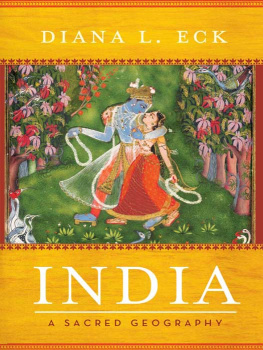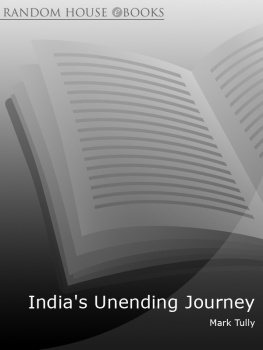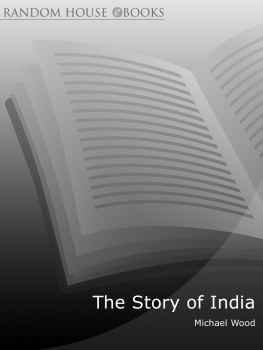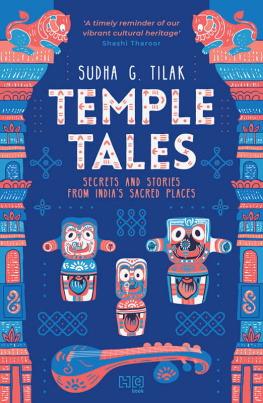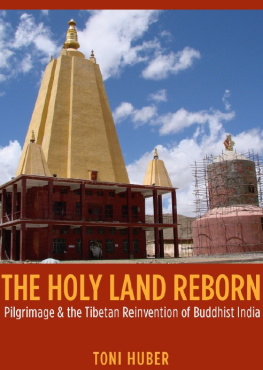

Copyright 2012 by Diana Eck
All rights reserved.
Published in the United States by Harmony Books, an imprint of the Crown Publishing Group, a division of Random House, Inc., New York. www.crownpublishing.com
Harmony Books is a registered trademark and the Harmony Books colophon is a trademark of Random House, Inc.
Library of Congress Cataloging-in-Publication Data
Eck, Diana L.
India : a sacred geography / by Diana L. Eck.1st ed.
p. cm.
1. IndiaReligion. 2. Sacred spaceIndia. 3. HinduismIndia. I. Title. BL2001.3.E25 2011
294.50954dc22 2011009237
eISBN: 978-0-385-53191-7
All photos courtesy of the author, except , Krishna Lifting Mount Govardhan , attributed to Mola Ram (1760-1833)
Maps by C. Scott Walker, Digital Cartography Specialist, Harvard Map Collection; map, , by Michael Gellatly
Jacket design by Nupoor Gordon
Jacket painting: Detail of Radha and Krishna Walking in a Flowering Grove (recto) The Metropolitan Museum of Art, Image source: Art Resource, NY
v3.1
TO DOROTHY ECK AND DOROTHY AUSTIN
THE TWO DOROTHYS, BOTH GIFTS OF GOD
C ONTENTS
N OTE ON T RANSLITERATION AND
P RONUNCIATION
While Sanskrit is said to be the perfectly made and polished speech of the gods, those of us who are mortal and write in English have to simplify the transliteration for ease of reading. In this book, I have kept diacritical marks to a bare minimum, using only the long mark, or macron, important for the proper pronunciation of short and long vowels.
| a (as allow: Shiva) | (as in father: Ksh) |
| i (as in it: linga ) | (as in magazine: dev ) |
| u (as in put: Upanishad) | (as in rude: Chitrakt) |
For consonants, I have written both the retroflex s (with a dot under it as in Vinu) and the palatal s (with an accent mark as in iva) as sh, since this is basically how they are pronounced. Other distinctions in this precisely articulated language have also been lost here.
Aspirated consonants (those followed by an h) are pronounced as follows: bh as in clubhouse, Bhagavad Git ; dh as in roundhouse, dharma ; th as in hothouse (trtha) . Two-syllable words are usually accented on the first syllable: Shi va, Vish nu, dhar ma . In words of more than two syllables, the penultimate syllable is accented if it contains a long vowel (Vishva n tha, Purna) or a dipthong (Kuru ksh etra). Otherwise, the accent is on the antepenultimate (third from last) syllable, as in Ra m yana, Maha bh rata, Amara kan taka, R vana, Laksh mana.
Another issue is that of Sanskrit and Hindi transliteration. The most noticeable difference between Sanskrit and Hindi words is the presence of the final short a in Sanskrit and its absence in Hindi. For example, darshana (seeing the divine image) becomes darshan in Hindi, Ganesha becomes Ganesh, Prayga becomes Prayg. I have not chosen one form exclusively over the other, but have tried to be consistent to the context. For example, if the reference is to a Sanskrit text, I might use Somantha, but on the whole I have kept the form in which these words are most easily recognizable today, which would be Somnth. (Similarly, Badrnth rather than Badarntha, Hardvr, rather than Haridvra, Chitrakt rather than Chitrakta.) Even when I switch back and forth, the reader will soon adjust to the fact that this is simply the complexity of an ancient, yet modern, culture.
Finally, we should note that so many of the major cities of British India have now claimed official Indian names: Mumbai rather than Bombay; Chennai rather than Madras; Kolkata rather than Calcutta; Tniruvananthapuram, rather than Trivandrum. I have used both forms, since both are still in common parlance. I have not used diacritical marks on cities, states, common mountain ranges, or other geographical features, with the exception of rivers.



I began thinking about this book in the city of Banras on the River Gang in north India more than twenty-five years ago. I was then writing a book about that great city, a place I presumed to be the most important sacred city of India. Over the centuries, many visitors to Banras, or Vrnas, have compared this city in sanctity and preeminence to Mecca, Jerusalem, and Rome, as the holiest center of Hindu pilgrimage. For example, in the 1860s, a British civil servant, Norman Macleod, wrote effusively, Benares is to the Hindoos what Mecca is to the Mohammedans, and what Jerusalem was to the Jews of old. It is the holy city of Hindostan. I have never seen anything approaching to it as a visible embodiment of religion; nor does anything like it exist on earth. This is a powerful and ancient city, its dense maze of alleyways as dark as its riverfront is radiant. Its morning bathing rites facing the rising sun and its smoking cremation grounds right there along the riverfront are the heartbeat of a city that never fails to leave a lasting imprint on the visitor or pilgrim.
I lived off and on for years in Banras. Even as I investigated the legends and temples of this city, however, I began gradually to understand what most Hindus who visit the city already knowthat Banras does not stand alone as the great center of pilgrimage for Hindus, but is part of an extensive network of pilgrimage places stretching throughout the length and breadth of India. The very names of the temples, the ghts , and the bathing tanks of the city are derived from this broader landscape, just as the names of Ksh and its great Shiva temple of Vishvantha are to be found in pilgrimage places all over India. I began to realize that the entire land of India is a great network of pilgrimage placesreferential, inter-referential, ancient and modern, complex and ever-changing. As a whole, it constitute what would have to be called a sacred geography, as vast and complex as the whole of the subcontinent. In this wider network is pilgrimage, nothing, not even the great city of Banras, stands alone, but rather everything is part of a living, storied, and intricately connected landscape.

The bathing ghts of Kshs great riverfront
At first, I resisted the complexities of this peripheral vision, still interested as I was in establishing what makes this one place special, different from the rest. It became clear to me, however, that I could understand Banras only in the context of a much wider system of meanings in which significance is marked not by uniqueness, but by multiplicity, even in the great city of Ksh. Everything about the holy city seemed to be duplicated elsewhere, set amid a pattern of symbolic signification that made Banras not unique, but inextricably part of a wider landscape shaped by the repetition and linking of its features. I began to realize that Ksh was not the center, but one of multiple centers in a fascinating and poly-centric landscape, linked with the tracks of pilgrimage.
The most important of the religious claims of this sacred city is that Ksh, the City of Light, is a place of spiritual liberation, which is called moksha or mukti. Kashym maranam muktih , they say. Death in Ksh is liberation. Pilgrims come to Ksh from all over India to live out their old age and die a good death there. In this, Ksh is special, famous for death, some would say preeminent. And yet Ksh is also said to be one of seven cities that bestow moksha , including Ayodhy, Mathur, Hardvr, Knch, Ujjain, and Dvrak. These seven are all called mokshadyaka , the givers of spiritual freedom. Ksh is also said to be the earthly manifestation of Shivas luminous sacred emblem, the linga of light, where Shivas infinite shaft of light pierced the earth. And yet so are at least eleven other places, all renowned throughout India, the whole group known as the twelve lingas of light. As I studied Banras years ago, their names were just names to me, although each of these renowned sites of Shiva was represented by a temple within the sacred structure of Ksh, as well. I began to realize that the famous goddesses of Ksh are also linked to hundreds of goddesses in a network of association called the shkta pithas , or power seats, of the Goddess. The River Gang, skirting the city, with its famous bathing ghts , is one of the seven Gangs of India, including the Narmad, Godvar, and Kver Rivers, each of which lays claim to the heavenly origin and gracious power of the Gang that flows past Banras in north India. This whole sacred zone of Ksh is said to have a radius of five kroshas , about ten miles, and this zone is circled by a famous five-day pilgrimage called the panchakrosh , with five stops along the way. Gradually, I discovered that the panchakrosh is not a unique pilgrimage, but a type of fivefold pilgrimage that is also found in Ayodhy, in Omkreshvara on the Narmad River, on Mount Brahmgiri in Maharashtra, and in dozens of other places. And, to top it off, Ksh itself is duplicated, with cities and temples all over India called the Ksh of the South, the Ksh of the North, or the Hidden Ksh of the Himalayas.
Next page
